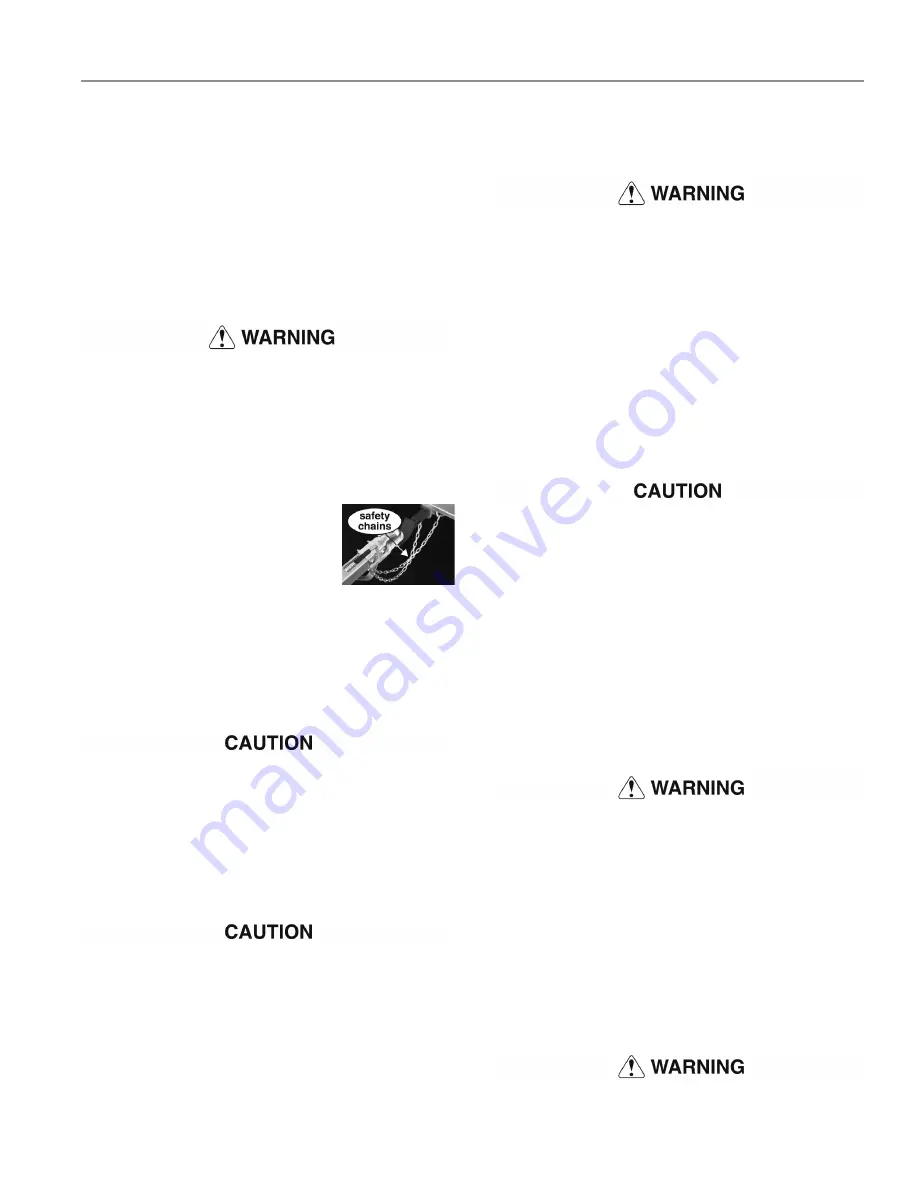
being careful to keep the towed vehicle centered. As
the towed vehicle reaches the top, the ramps will au-
tomatically raise. Continue forward until the tires touch
the ramp stop.
All towed vehicles must be loaded forward, with
the steerable wheels on the tow dolly. The front end
of the towed vehicle is aligned with a small amount
of “toe-in” to help keep it in a straight line as you
drive. By towing backwards you reverse the effect,
causing the towed vehicle to wander, sway and
fishtail. This can cause loss of control, resulting in
property damage, personal injury or even death.
9.
Now, lock or otherwise secure the steering wheel
so that the front end cannot pivot on the dolly. If the
vehicle is not equipped with a locking steering column,
you must secure the steering wheel so that it cannot
turn while being towed.
Failure to lock the steering wheel will allow the
towed vehicle to pivot on the bed, causing it to
hit the fender and wheel assemblies of the dolly.
Severe damage to both vehicles will result.
10.
Put front wheel drive vehicles in park. If it is a rear
wheel drive, make certain it can be pulled with the rear
wheels on the ground without damaging the transmis-
sion. If it can be safely towed, put the towed vehicle
in neutral. If not, remove the driveshaft and put in park
(in gear if a manual transmission).
11.
If the towed vehicle's emergency brakes apply the
front wheels, set the emergency brake. Do not set the
emergency brake if it applies the rear wheels.
Do not set the emergency brake if it applies the
rear wheels, or severe brake damage or fire may
result.
12.
Connect the bed safety chains to secure points
under the towed vehicle. Leave some slack to allow
for movement of the suspension when towing.
13.
While under the towed vehicle, check that the tilt
latch has fully engaged, securing the bed in the raised
position. Verify each time before towing. If the tilt latch
is not fully engaged, the ramps will tilt while towing.
14.
Now, secure the towed vehicle to the dolly with the
TieDown
™
straps…
Be certain that the TieDown straps do not touch
any components behind the wheel, such as struts.
continued on next page
Loading
1.
Park the motorhome on a flat, level surface. Make
sure that the motorhome’s engine is off, with the trans-
mission in park, and that the emergency brake is on.
2.
Position the dolly in line with the motorhome and
place the coupler over the trailer ball. Make certain that
the coupler socket fully encloses the hitch ball. Secure
the coupler to the ball by fully lowering the coupler lever
into a horizontal position, as shown in Figure 6.
Pull up on the tow dolly tongue to verify that the
coupler is properly latched and is securely attached to
the trailer ball.
Always connect the dolly to the motorhome be-
fore loading the towed vehicle. It is nearly impos-
sible to control the combined weight of the dolly
and towed vehicle when disconnected from the
motorhome. Attempting to do so may cause prop-
erty damage, personal injury or even death.
3.
Attach the safety chains to the receiver on the mo-
torhome and cross the chains, as
shown in the photo to the right.
Crossing the safety chains will help
prevent the tongue from catching
on the road in case of disengage-
ment.
Leave just enough slack in the chains for turning
sharp corners.
4.
Connect the tow dolly’s wiring plug to the motor-
home’s socket and check the lights for proper func-
tion.
5.
Remove the steering pin (see Figure 6).
With the steering pin in place, the towed vehicle
will attempt to pivot on the dolly when turning cor-
ners. Failure to remove the steering pin will force
the towed vehicle into the dolly fenders, resulting
in severe damage to both vehicles.
6.
Tilt the ramps to the ground by pulling the bed tilt
lever (see Figure 6).
The TieDown ratchets must be in the down po-
sition when loading. If the ratchets are left in the
up position, they may catch on the towed vehicle,
resulting in damage to the vehicle.
7.
If the towed vehicle has a rock guard, spoiler, air
dam or other undercarriage component, check to en-
surethat it will clear the ramps and deck without damage.
8.
Now, align the towed vehicle with the dolly and
have an assistant carefully guide you up the ramps,
9
USING YOUR TOW DOLLY




















